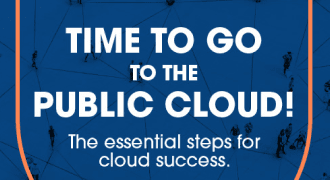
Whitepaper
Time to go to the public cloud!
In this paper, I talk about the power of the public cloud for telcos and lay out the four clear steps you need to take to trigger your transformation. As you’ll discover, it’s not about transition…
OK, so you read my last blog, How to start your move to the cloud. You followed my advice about planning the transition, working with your executive team, hosting workshops, hanging posters up around the office with catchy slogans to rally the troops. You worked closely with your human resources (HR) partners. People are ready. Now what?
As my mother always says, “How do you eat an elephant? One bite at a time.”
There are two major types of workloads to move to the public cloud: IT and network. My advice to telco executives: start with IT. Why?
Because network workloads are more complicated; have more requirements on uptime; have more demands on latency. You know what doesn’t have a lot of these issues? IT. So to start, get your feet under you with IT workloads.
The first bite is to make a list of all your IT apps—likely thousands of them (AT&T had 2000). Open up a spreadsheet, write them down, then categorize them into easy to move, harder to move, and hardest to move. Pick a way to group them that makes the most sense for your business, and get sorting. You might categorize them by number of users, how mission-critical they are, how expensive they are to run—it doesn’t really matter, and everybody does it differently, a point underscored in this piece by TM Forum chief analyst Mark Newman about how three operators have approached their moves. (If you need help, give us a call! TelcoDR happens to offer this exact service. This is our jam!)
Begin where the stakes are lowest, because you’re going to learn a lot of things you didn’t know about the public cloud when you get underway. Cut yourself some slack at the beginning. There will be mistakes. Once you sign an agreement with AWS, Microsoft Azure or Google Cloud, there are a lot of new things to think about: governance, legal and compliance issues, security, how to manage changes. It’s complicated. Plus, your apps have been on-prem for years—decades even.
But really, the bottom line is this: Pick something in your easy bucket, anything, and move it.
When Jaime Miller was the CIO of General Electric, she brought her technical leaders together and told them that the company was going to move 50 applications to the public cloud. The team balked, argued, said it was a dumb idea and that it wouldn’t work. She acknowledged their concerns, but also asked them to take a month and do the best they could. Thirty days later, they’d moved 42 apps. Not only did it work, but during that time, the team also learned about their questions, roadblocks, workarounds, and other things. More importantly, they got excited. They saw opportunities for other apps to move, for how to do things better and faster. Now, GE has moved thousands of apps to the public cloud. By setting a goal, Jaime Miller kicked off a flywheel that is still turning today.
You can stand around and kick the tires, move one thing, fire up a server. It’s easy to experiment with the cloud but it’s another to intentionally move everything over. A good test to see if you’re making progress—is your spending going up? This is an easy report to run each month to see if there’s activity, or if people are just playing around with the cloud. The time to move to the public cloud is NOW. If you don’t build momentum now, you’re going to fall behind the rest of the industry quickly. This effort is going to take YEARS (yes, years), so get going.
It’s time to start eating the elephant. 🐘 🍽 ⛅️
Recent Posts

 Get my FREE insider newsletter, delivered every two weeks, with curated content to help telco execs across the globe move to the public cloud.
Get my FREE insider newsletter, delivered every two weeks, with curated content to help telco execs across the globe move to the public cloud.